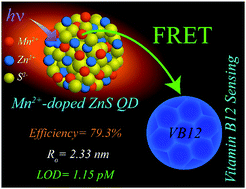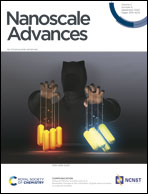The quantum dot-FRET-based detection of vitamin B12 at a picomolar level†
Abstract
Herein we report the picomolar level detection of vitamin B12 (VB12) using orange-red emitting ligand-free Mn2+-doped ZnS quantum dots (QDs; λem = 587 nm) in an aqueous dispersion. Sensing was achieved following the quenching of the luminescence of the Mn2+-doped ZnS QDs with an increasing concentration of VB12. The Stern–Volmer constant was determined to be 5.2 × 1010 M−1. Importantly, the Mn2+-doped ZnS QDs exhibited high sensitivity towards VB12, with a limit of detection as low as 1.15 ± 0.06 pM (in the linear range of 4.9–29.4 pM) and high selectivity in the presence of interfering amino acids, metal ions, and proteins. Notably, a Förster resonance energy transfer (FRET) mechanism was primarily proposed for the observed quenching of luminescence of Mn2+-doped ZnS QDs upon the addition of VB12. The Förster distance (Ro) and energy transfer efficiency (E) were calculated to be 2.33 nm and 79.3%, respectively. Moreover, the presented QD-FRET-based detection may bring about new avenues for future biosensing applications.

- This article is part of the themed collection: Quantum and carbon dots


 Please wait while we load your content...
Please wait while we load your content...